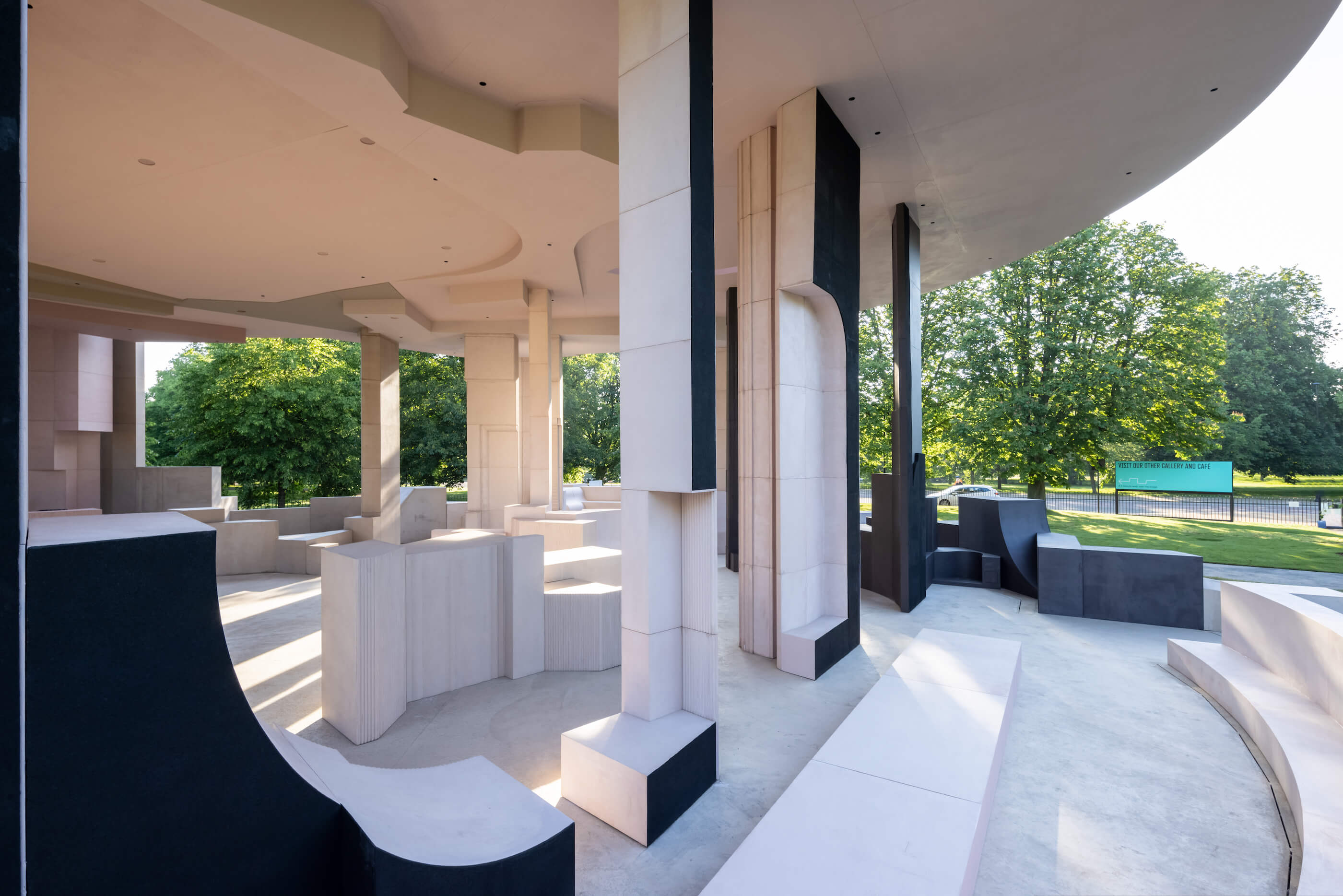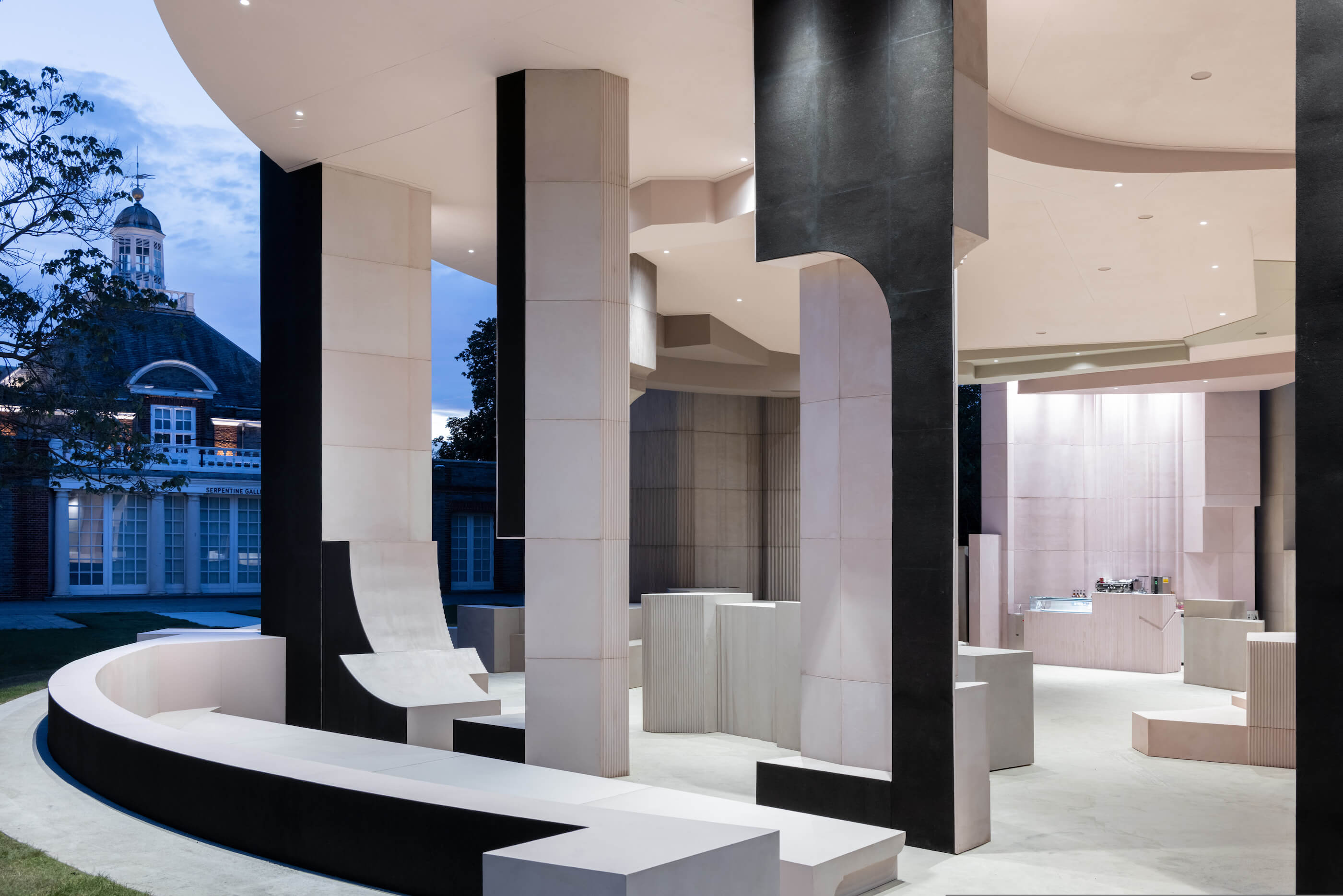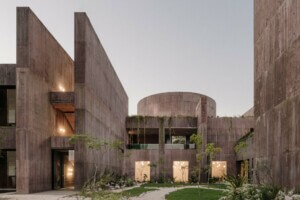Designed by Johannesburg, South Africa-based collaborative architectural studio Counterspace, the 20th Serpentine Pavilion goes on public view this week—on June 11, to be precise—at its customary location: A grassy expanse of lawn at the Serpentine Galleries in Kensington Gardens, Hyde Park, London. While said lawn has welcomed high-profile works of temporary architecture for three-month summertime runs (save for last year) since 2000 with an inaugural commission by Zaha Hadid, this is the first Serpentine Pavilion in the history of the program in which fragments of the main structure extend behind beyond Hyde Park and can be found elsewhere across London.
These satellite elements of Counterspace’s Serpentine Pavilion, a concrete structure with a design, per the Serpentine, “based on past and present places of meeting, organising, and belonging across London,” can be found at a quartet of different partner sites and are meant to spur “gatherings and impromptu interactions” while honoring specific places of community-strengthening assembly. The venues are New Beacon Books, a venerable Black bookseller and publisher in Finsbury Park; The Tabernacle, a historic Protestant chapel-turned-neighborhood hub in Notting Hill; the Albany, a buzzy arts center in Deptford, southeast London, and the newly opened Becontree Forever Arts and Culture Hub at Valence Library in Barking and Dagenham.
Back in Kensington Gardens, the 2021 Serpentine Pavilion serves as an architectural amalgamation of sorts, referencing various sites across the city, namely houses of worship, restaurants, markets, bookshops, theaters, and other gathering spaces that are of vital importance to London’s “diasporic and cross-cultural communities.” Its form, per the Serpentine, is the result of “abstracting, superimposing, and splicing architectural elements, varying in scales of intimacy, from various locations, translating the shapes of London into the Pavilion structure.” Just a few of the many diverse sites, some of them existing, some of them erased, that Counterspace referenced and paid homage to are the Four Aces Club, the East London Mosque, Brixton Market, the Islamic Centre of England, Electric Cinema, Club Eleven, and Railton Road.

“My practice, and this pavilion, is centered around amplifying and collaborating with multiple and diverse voices from many different histories; with an interest in themes of identity, community, belonging and gathering,” elaborated Sumayya Vally, director of Counterspace, in a statement. “The past year has drawn these themes sharply into focus and has allowed me the space to reflect on the incredible generosity of the communities that have been integral to this pavilion. This has given rise to several initiatives that extend the duration, scale and reach of the pavilion beyond its physical lifespan. In a time of isolation, these initiatives have deepened the pavilion’s intents toward sustained collaboration, and I am excited to continue this engagement with the Serpentine’s civic and education teams and our partners over the summer and beyond.”
Chief among the initiatives mentioned by Vally, who is notably the youngest architect to be commissioned to design the Serpentine Pavilion in the history of the program, is Support Structures for Support Structures. A fellowship program launched to mark the 20th anniversary of the Serpentine Pavilion, Support Structures for Support Structures is open to ten London-based artists and artistic collectives working at the intersection of art, spatial politics, and community practice. Each awarded fellow will receive grants of up to roughly $14,100 (£10,000) to develop and execute work while being inviting to partake in an interdisciplinary network for “support, development workshops, and mentoring,” according to the Serpentine. The awardees will be announced next month.
Featuring aural installations by artists including Jay Bernard and Ain Bailey, a special program for the Pavilion dubbed Sounds of the City will introduce Serpentine visitors to the “stories and sounds of lost spaces” across the British capital city. Additional special summertime programming coinciding with the 2021 Serpentine Pavilion will be announced throughout the summer.
Counterspace’s 2021 Serpentine Pavilion was technically first unveiled as the 2020 Serpentine Pavilion. While Counterspace and its all-female team was announced in February 2020 as the designer of that year’s work of pop-up architecture, the program was suspended due to the coronavirus and pushed back to this summer.
“The spirit of community that has carried us as an institution throughout such a challenging year is the same that we hope to enliven this project,” said Serpentine artistic director Hans Ulrich Obrist and chief executive Bettina Korek said in a joint statement. “Here’s to a new chapter.”

For the seventh consecutive year, financial support for the Serpentine Pavilion was provided by Goldman Sachs, with spa operator Therme Group serving as a supporting partner. David Glover served as a technical consultant while global engineering giant AECOM acted in a technical advisory role for the ephemeral installation, which has been subject to some raised eyebrows due to its (apparent) carbon-intensive concrete composition. “The embodied carbon from the Pavilion build has been studied in detail and monitored throughout the design and construction process,” elaborated the Serpentine. “Through innovative material selection, and measures to ensure the main structure can be easily dismantled and reused, the result is a carbon-negative Pavilion and a positive net outcome.”
In mid-May, Chicago-based artist and urbanist Theaster Gates was announced as the designer of the 2022 Serpentine Pavilion. He is the first non-architect to win the commission in the initiative’s 21-year history. In addition to inaugural Pavilion designer Zaha Hadid, past architects to be selected for the prestigious commission include Oscar Niemeyer (2003), Frank Gehry (2008), Sou Fujimoto (2013), Bjarke Ingels (2016), Frida Escobedo (2018), and Junya Ishigami (2019).
The 2021 Serpentine Pavilion, as mentioned opens on June 11 and is on view through October 17, 2021. Although advanced ticketing is required for most exhibitions and programming, including live events, held at and on the grounds of the Serpentine Galleries, visiting the Serpentine Pavilion is free with no ticketing required.











